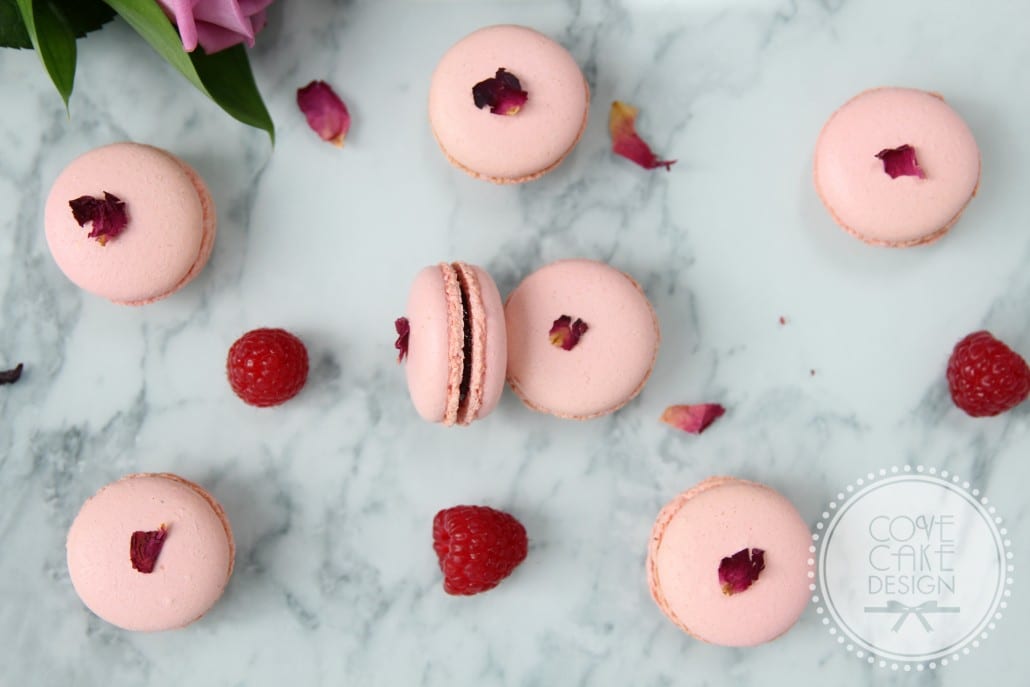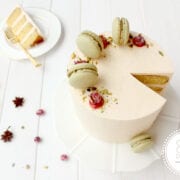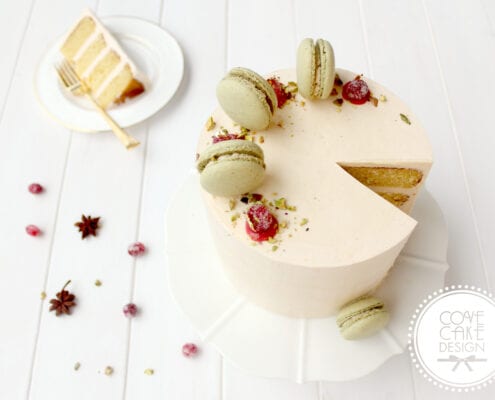Macarons – Rose and Raspberry Recipe
I have always had a little love for macarons. For many years my husband has flown for work with Air France which has meant regular routings via Paris. Whilst I was still a poor student, and long before macarons had made a major appearance in Ireland, he would bring me home beautiful little packages of pastel-coloured goodness from the airport’s branch of Ladurée. Such a treat!
When I started my cake business, macarons became something that I wanted to make myself. They are so beautiful as wedding favours, or as additions to a cake table, and the flavour combinations are endless!
Macarons are however notoriously difficult to make. There are many variables that can affect the ability to get perfectly identical macarons with a smooth top, nice feet, crispy shell and soft chewy middle. These variables range from underwhipping to overwhipping the egg whites, under-resting or over-resting, baking temperature, under-baking or over-baking, the weather, phase of the moon..(!)..etc.
My biggest stumbling block was collapsed insides. The macarons would look perfect, with shiny tops and nice feet, but inside was just a large airpocket. I discovered that this was due to them not being completely cooked inside which caused them to collapse when taken out of the oven. After some experimentation I found that a change in the baking temperature solved the problem!
Having found what methods work for me in my kitchen I am now addicted to making macarons and playing with flavours! So here I have decided to share some of what I have learned and what methods I use as well as a favourite recipe.
French or Italian
Macarons can be made by the French meringue method whereby the egg whites and caster sugar are whipped into stiff peaks of meringue before adding the almond meal mixture, or the Italian method in which a hot sugar syrup is added to whipped egg whites to make the meringue. Having experimented with both I now prefer the Italian method, as it gives smoother shinier tops and is also more consistent due to the meringue being more stable.
To age or not to age
Many recipes say to age the egg white before use which dries them out whilst maintaining the protein structure, hence making them more elastic and better for whipping. I sometimes age the egg white and sometimes don’t depending on my time constraints. I have never found a difference so don’t see it as critically important for success.
Silicone or baking parchment
I started off using baking parchment but found that I got lopsided macarons at the edges of the tray. I believed this was because the parchment wasn’t completely flat having been taken off a roll. I moved to silicon mats and no longer had lopsided macarons. My mats aren’t specifically for macarons so don’t have a template. I hence just count to 3 when I am piping the mixture. With the pressure that I use this gives me the size of macarons that I want. I do find that macarons take a little longer to cook on silicon than on parchment.
Trays
In the early days I invested in a beautiful large heavy duty baking tray to maximise the chances of macaron success. However when in need of extra trays I now also use some older cheaper ones and don’t see a difference in results dependent on the type (or cost!) of tray I use.
Resting
This I have found is essential. The theory behind resting your macarons is that a skin forms on top and when they are put in the oven and begin to rise the air is forced out at the bottom creating those lovely feet. There have been times when the weather has been damp or for some unknown reason my macarons have taken too long to form a skin. When I put these in the oven I get little/no feet and burst tops as the air escapes from the top instead. To speed up skin formation I sometimes put my trays under the light of my extractor fan which gives off a little heat or in a room with my dehumidifier. I also try to plan my macaron making for dry days!
Temperature and baking time
I started off baking at 150°C for 14-16mins, removing the macarons when they no longer had a ‘wobble’ which shows they were cooked (or so I thought). However, they were collapsing completely on cooling which I discovered was due to the fact the insides weren’t actually cooked enough. I experimented with different temperatures and found that by baking my macarons at 170°C for approx 15mins they came out perfect! Any longer and they started to brown on top, any less and they weren’t cooked. I do however think that the temperature and cooking time is something that needs to be tested under each baker’s tray/oven conditions.
And finally…a recipe for one of the first flavours I worked on and a really lovely one, Rose and Raspberry!
Rose and Raspberry Macarons
Ingredients:
- 100g ground almonds
- 100g icing sugar
- 100g caster sugar
- 40ml water
- 2x40g egg white (not pasteurised)
- Red paste food colour
- 1/2 – 1tsp of rosewater to taste
- Good quality raspberry conserve (I make my own but there are so many good brands out there too!)
Step 1: Grind the almond meal and icing sugar in a food processor for 1-2 mins until powdery. Sieve into a clean metal bowl and discard any larger pieces. Add 40g egg white, the rosewater and some red food colour and mix using a spatula until a paste is formed and the colour is evenly distributed. The colour will lighten on addition of the meringue and also during baking so make sure the colour is darker than required for your finished macarons.
Step 2: Place the caster sugar in a small saucepan and add the water. Bring to the boil without stirring but swirling now and then to ensure even heating. Make sure there are no sugar crystals around the edges of the saucepan and if so, use a pastry brush dipped in a little water to brush the sugar back down into the syrup. Use a sugar thermometer to ensure the temperature of the syrup does not pass 115°C.
Step 3: Meanwhile, begin to whisk the second 40g egg white to soft peaks in a spotlessly clean metal bowl. Increase the speed of the mixer as the temperature of the sugar syrup passes 105°C. When the syrup reaches 115°C remove from the heat and slowly pour the syrup in a steady stream into the egg whites. Take care to pour the syrup onto the whites and not onto the whisk or edge of the bowl. Continue to whisk on high speed for 5-10mins until the bowl is cool to the touch and the meringue forms stiff peaks.
Step 4: Using a spatula, incorporate a third of the meringue into the almond paste mixture to loosen the paste a little. Then add the rest of the meringue. Work the batter by sweeping the spatula around the edges towards the centre and scraping from the bottom up over the top. This is called ‘macronage’. The batter is ready when it has a ‘flow’. Test by making a small peak in the batter and seeing if it begins to disappear back into the mixture.
Step 5: Fill a piping bag fitted with a 1.5cm or similar round nozzle. Line 1-2 baking trays with a silicone baking mat or baking parchment. (If using parchment, stick down on the tray at the four corners with a little of the macaron batter). Pipe out regular circles of batter leaving a little space in between each one. When finished lift the tray and drop onto the countertop to release air bubbles and help settle the macarons. If any air bubbles are visible that haven’t popped use a small cocktail stick to do so.
Step 6: Leave the macarons to rest to form a skin on top. They are ready when you can lightly touch the surface with your finger and no mixture comes away.
Step 7: Meanwhile preheat the oven to 170°C. When the macarons are ready to be cooked place in the oven and bake for 14-16mins turning the tray midway through. They are cooked when they no longer wobble when you gently try to move one from side to side.
Step 8: Remove from the oven and leave to cool completely before removing from the tray. Store in an airtight container until ready to be filled.
Step 9: To assemble the macarons, first match them up in pairs. Using a teaspoon or piping bag put some raspberry jam on one half of each macaron and sandwich the other on top. Take care not to overfill. Store in an airtight container in the fridge for a day before enjoying!





